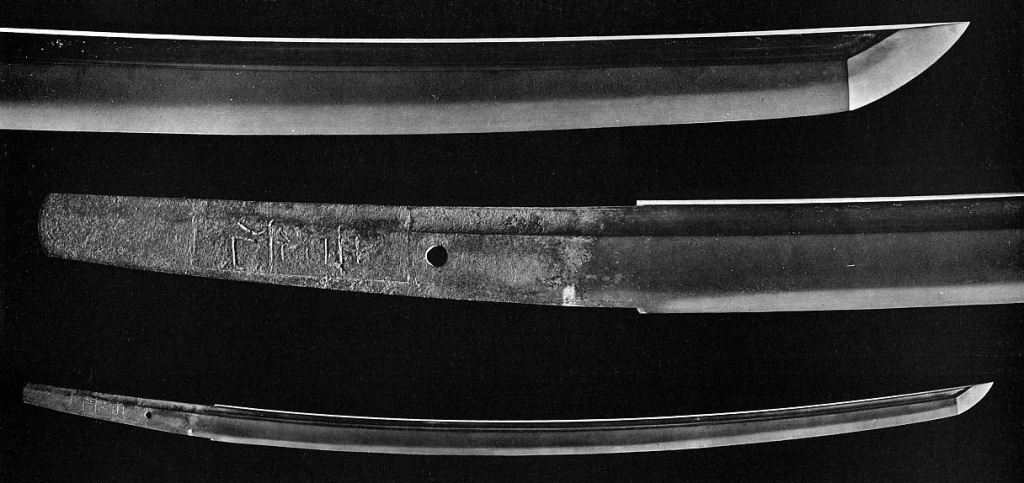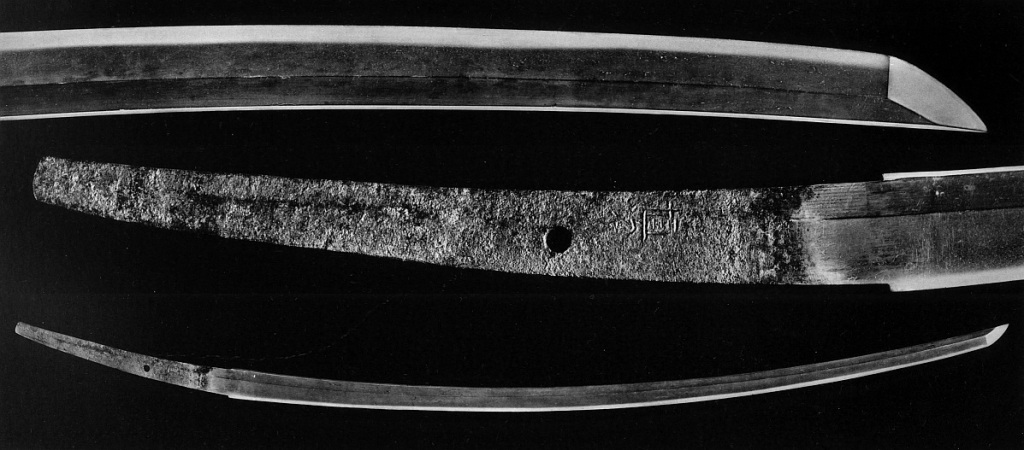In this chapter I would like to introduce the last of the tenka-goken, the so-called Juzumaru (数珠丸) by the swordsmith Tsunetsugu (恒次). The sword was once in the possession of the great Buddhist reformer Nichiren (日蓮, 1222-1282). When he returned from a bakufu-imposed exile to the island of Sado (佐渡) to Kamakura in Bun´ei six (文永, 1274), he was invited by Nanbu Sanenaga (南部実長, 1222-1297) to the district of Hakii (波木井) in Kai province who was under his control. Sanenaga allowed him that he build up his hermitage on the local Mount Minobu (身延山). Later this hermitage was upgraded to the Kuon-ji (久遠寺, present-day Yamanashi Prefecture) on whose grounds also Nichiren´s grave is located. Sanenaga was one of the most important patron of Nichiren and the later Kuon-ji and so he presented Nichiren with a sword of Tsunetsugu for his protection. For Nichiren this sword was merely a symbol for the “destroying of inquinity and establishing righteousness” (hajakenshō no tsurugi, 破邪顕正の剣), and so he hung a Buddhist rosary (juzu, 数珠) over its hilt which gave him the name Juzumaru-Tsunetsugu.
This story about the history of the sword is already found in the Kyōhō Meibutsu Chō but it is also noted that the three most important relics of Nichiren – his stole (kesa, 袈裟), his ceremonial fan (chūkei, 中啓), and the Juzumaru-Tsunetsugu – were already no longer preserved in the Kuon-ji at the time the Meibutsu Chō was compiled, this in the Kyōhō era (享保, 1716-1736). About twohundred years later, in October 1920, the blade was rediscovered by those Sugihara Shōzō (杉原祥造) who wrote down also the legend to the Yamauba-Kunihiro (see this story). Sugihara was then among others responsible for the blades of the Imperial Household Agency (kunai-shō, 宮内省), that means he was a renowned expert on swords. He found the blade among items of a certain aristocrat who put off parts of his collection for auction. He placed a huge bid at the upcoming auction because he feared that the sword could leave Japan forever at a highest bid from abroad. Sugihara caused a further stir in the then sword world when he invidted all newspapers to write about his rediscovering of the Juzumaru-Tsunetsugu. One year later it was designated as national treasure. Sugihara actually tried to return the sword to its place where it belongs, i.e. the Kuon-ji, but the negotiations failed because the temple was not able to raise the funds to buy it from him. After tough negotiation a common ground was established and the sword was given to the Honkō-ji (本興寺), a temple near Sugihara´s hometown Amagasaki (尼崎) in Hyōgo Prefecture. As precious supporter for the temple acted the as religious as rich Ōsaka paper wholesaler Kitakaze Kumashichi (北風熊七). The Juzumaru-Tsunetsugu is still preserved in the Honkō-ji and is designated as jūyō-bunkazai.
jūyō-bunkazai Juzumaru-Tsunesugu, mei: “Tsunetsugu,” nagasa 81.0 cm, sori 3.0 cm, deep koshizori, funbari, chū-kissaki, ubu-nakago
There is an uncertainty about the smith Tsunetsugu or rather which Tsunetsugu made the blade. Traditionally, the Ko-Aoe school (古青江) smith Tsunetsugu who worked around the Shōgen era (承元, 1207-1211) is considered as maker. But the blade of the Juzumaru shows some differences to the workmanship and way of signing of this school. That means it does not have the Aoe-typical chirimen (縮緬) forging structure, and smiths of the Ko-Aoe school signed on the haki-ura side (佩裏) of the tang, the side which faces the wearer when mounting the blade as tachi edge down from the belt. However, the signature of the Juzumaru-Tsunetsugu is on the haki-omote (佩表) side. And so some say it might be a work of the Ko-Bizen smith (古備前) Tsunetsugu who worked around Genryaku (元暦, 1184-1185).
But let´s stay at the tenka-goken for a while. Sometimes the sword Ichigo-Hitofuri (一期一振) is wrongly listed as one of the “Five Great Swords” instead of the Onimaru-Kunitsuna. The blade is a work of Awataguchi Yoshimitsu from this story and originally came from the possessions of the Asakura family (朝倉) of Echizen province. When the family was destroyed in the course of Oda Nobunaga´s seizure of power in the first year of Tenshō (1573), it was handed-over to the Mōri family, and later it was presented by Mōri Terumoto (毛利輝元, 1553-1625) to Toyotomi Hideyoshi. As Hideyoshi was rather on the short side, he had the blade shortened from 2 shaku 8 sun 3 bu (~ 85.7 cm) to 2 shaku 2 sun 7 bu (~ 68.8 cm) but ensured that the original signature of Yoshimitsu was set into the new tang as so-called gaku-mei (額銘, see picture below). Also the nickname of the sword goes back to Hideyoshi whereas there are two theories about it. The first says that he had until the last no opportunity to ever use the sword and so he called it “one sword stroke (hitofuri, 一振) in a lifetime (ichigo, 一期).” The second theory says that it was the one and only tachi made by Awataguchi Yoshimitsu, who was famous for his tantō as we have learned here. Because furi (振り) is a Japanese word for counting blades: “One blade in a lifetime.”
gaku-mei “Yoshimitsu” of the Ichigo-Hitofuri
 tachi, gyobutsu, gaku-mei “Yoshimitsu,” nagasa 68.8 cm, sori 2.6 cm, shinogi-zukuri
tachi, gyobutsu, gaku-mei “Yoshimitsu,” nagasa 68.8 cm, sori 2.6 cm, shinogi-zukuri
After the death of Hideyoshi the sword remained in family property but suffered a fire damage when Ōsaka Castle was lost in 1615. The new owner Ieyasu ordered the smith Yasutsugu (康継) to apply a new tempering which turned out to be very excellent. The sword remained subsequently in the possession of the Owari branch of the Tokugawa until the then head Tokugawa Mochinaga (徳川茂徳, 1831-1884) presented it to Emperor Kōmei (孝明天皇, 1831-1866, r. 1846-1866) in Bunkyū three (文久, 1863), and it is still a gyobutsu (御物), i.e. an Imperial treasure.
There are two other blades, both of them designated as jūyō-bunkazai, which bear a nickname very similar to the Ichigo-Hitorifu, namely Ichigo-Hitokoshi (一期 一腰). Koshi is like furi and kuchi (口) a suffix for counting swords whereas koshi and furi is used for mounted, and kuchi for unmounted blades. This nomenclature comes from the fact that the former two are “ready for use,” that means they can be mounted at the waist (koshi, 腰) or they can be used for a strike (furi, 振り). But in the context of the Ichigo-Hitokoshi, the name refers to the best masterwork a smith ever made in his entire life (thus this could also be applied to the Ichigo-Hitorifu).
The first blade (see picture below) dates to the late Muromachi period and bears the detailed signature “Bizen no Kuni-jū Osafune Jirō´emon no Jō Katsumitsu, shi Jirōbei no Jō Harumitsu – Ichigo-Hitokoshi no saku – Sasaki Iyo no Kami” (備前国住長船次郎右衛門尉勝光子次郎兵衛尉 治光・一期一腰作之・佐々木伊予守). That means it is the best joint masterwork of Katsumitsu and his son Harumitsu from the Bizen-Osafune school, made for Amago Tsunehisa (尼子経久, 1458-1541) who was once a retainer of the Sasaki family and bore the honorary title Iyo no Kami. Around the 18th year of Bunmei (文明, 1486) Tsunehisa was able to successively gain control over the provinces Iwami, Oki, Bizen, Bitchū, Bingo, Haruma, Mimasama, Inaba, and Hōki, and this was the opportunity how he came to Bizen to have him forged this sword. Others say that Tsunehisa wanted to entrust his live to this blade – quasi the “sword of his life” – and that he had engraved this on the tang as Ichigo-Hitokoshi. Nowadays the blade is preserved in the Nogi-jinja (乃木神社) in Tōkyō where general Nogi Maresuke (乃木希典, 1849-1912) and seine Frau Shizuko (静子, 1859-1912) are worshipped. The Nogi are a branch family of the Amago.
jūyō-bunkazai, katana, mei: see text above, nagasa 64.5 cm, shinogi-zukuri, chū-kissaki, relative short ubu-nakago for a single-handed use (katate-uchi, 片手打ち)
The second blade called Ichigo-Hitokoshi is a wakizashi of Nobukuni (信国) from Yamashiro province. The entire signature reads: “Tatematsuru Fuji-Hongū – Minamoto Shikibu no Jō Nobukuni – Ichigo-Hitokoshi – Ōei nijūyon-nen nigatsu-hi” (奉富士本宮 源式部丞信国 一期一腰 応永廿四 年二月日) which translates as “offered to the Fuji Main Shrine – Minamoto Shikibu no Jō Nobukuni – the best masterwork of his life – on a day of the second month in the 24th year of (1417).” With the “Fuji Main Shrine,” the Fujisan-Hongū-Sengen-taisha (富士山本宮 浅間大社, Fujinomiya, Shizuoka Prefecture) is meant. Therefore the blade bears also the nickname Sengen-maru (浅間丸) or Asama-maru respectively (Asama is the Japanese reading of the characters Sengen). For unknown reasons the sword went out of the shrine later but was rediscovered and offered once again to the same shrine by Takeda Shingen in the 16th year of Tenbun (天文, 1547).



Oh hi I’m Hana.
I really really love your page. I and my friend are very indulged in nihontou and this page gave us so much information and background about it. So we want to translate your article into vietnamese cause there are a lot of people who have a strongly passion for nihontou same as us. We just translate it for our hobbies and we promise we never use our translation for any commercial purposes.
LikeLike
Hi Hana! You are very welcome to translate the page into Vietnamese. Just mention the website or my name in the credits. Thank you, Markus.
LikeLike
Oh thank you so much. I can’t say anything. Thank you for your permission.
I have just sent a friend request to you on facebook and I’m really happy that you accepted it. Thank you (again) 🙂
Wish you had a good day!
LikeLike
My pleasure 🙂
LikeLike
hello . can i to share this artickel to my blog but, in indonesian version ?
LikeLike
Yes, please feel free to share this article in Indonesian.
LikeLike
Hello, Markus!
I’m your reader from Russia. May I translate your articles to Russian and place them on my page in social networks?
LikeLike
Hi Pauline,
Absolutely. Please feel free to translate my articles to Russian and share them.
LikeLike